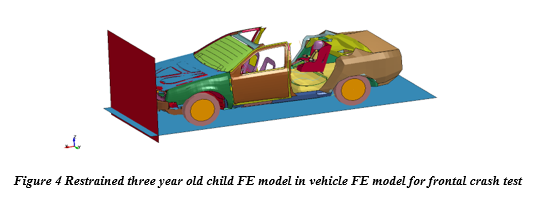An Optimized Sandwich Bumper Beam for Child Occupant Head Injury Prevention
Keywords:
Automotive crash, Sandwich bumper, Finite element method, Head injury criteriaAbstract
Child fatalities from motor vehicle crashes are recently being considered as a global problem. Various mitigation systems have been proposed, but are still not optimum. Designing energy absorption vehicle front has been one of the methods used to minimize vehicle deceleration. This in addition to child restraint seat could help minimize child injuries especially to the most sensitive part of human body, the head. Sandwich bumper beam absorbs huge kinetic energy by plastic deformation and lead to reduction of vehicle deceleration and subsequent lower occupant injuries. In this work, optimization was carried out seeking for the optimum design of composite beam thickness ( and foam thickness ( of a sandwich bumper that will minimize Head Injury Criteria ( and ) to child occupant at 48 km/h frontal impact. Sampling design of the bumper and beam thickness applying design of experiment and finite element (FE) crash simulations using LS DYNA was applied to evaluate the three year old (3YO) child model head injury responses. Optimization models were developed which were in turn used in optimization process. The optimization was carried out using polynomial Response Surface Method (RSM) for and . The bumper beam and foam thickness that gives a minimum and of 386.6 and 311.5 respectively are 100 mm with 1 mm . Lastly, the work, suggested the need for employing the relationship that exist between child occupant response and bumper material and thickness in design considerations.
Downloads
References
R. Bauer and M. Stelner, Injuries in the European Union: Statistics summary 2005-2007. 2009.
M. Starnes and A. M. Eigen, “Fatalities and Injuries to 0-8 Year Old Passenger Vehicle Occupants based on Impact Attributes,” 2002.
M. Andersson, “Child Safety in Car Crashes?: A Modeling Approach for Safety System Improvements,” Chalmers University of Technology, 2012.
J. S. Jermakian and M. A. Edwards, “Kinematics comparison between the hybrid III 6 year-old with standard pelvis and modified pelvis with GEL abdomen in booster sled tests,” Conf. Proc. Int. Res. Counc. Biomech. Inj. IRCOBI, vol. 2017-Septe, pp. 220–233, 2017.
P. He, X. Jiang, and J. Yang, “A Study on Rear Seat Occupant Injuries in Side Impact,” 2012 Third Int. Conf. Digit. Manuf. Autom., pp. 144–147, 2012.
K. D. Wu, J., Boyle, K., Orton, N. R., Manary, M. A., Reed, M. P., & Kliunich, “A Modeling Study on Child Occupant Safety With Unconventional Seating Configurations,” 2023.
H. Molla and A. Abuye, “Automobile Bumper Beam Analysis to Improve Energy Absorption,” Int. J. Sci. Eng. Res., vol. 11, no. 8, pp. 1603–1612, 2020.
A. Wikarta, R. Hakim, A. Shiddieqy, and I. Sidharta, “Mathematical Modelling of Engineering Problems Finite Element Simulation for Electric-Car Chassis Development from Scratch,” vol. 8, no. 2, pp. 279–284, 2021.
M. M. Davoodi, S. M. Sapuan, and R. Yunus, “Conceptual design of a polymer composite automotive bumper energy absorber,” Mater. Des., vol. 29, no. 7, pp. 1447–1452, 2008.
P. J. Schuster, “Current Trends in Bumper Design for Pedestrian Impact,” Sae 2006-01-0464, 2006.
M. Abbasi, R. Kazemi, and A. Ghafari Nazari, “Using a parametric method for investigating automotive crashworthiness,” Int J Automot Eng, vol. 1, no. 3, pp. 165–172, 2011.
Y. Abdel-Nasser, “Frontal crash simulation of vehicles against lighting columns using FEM,” Alexandria Eng. J., 2013.
H. Chen, Y. Yang, and L. Wang, “Vehicle Front Structure Energy Absorbing Optimization in Frontal Impact,” Open Mech. Eng. J., vol. 9, no. 1, pp. 168–172, 2015.
M. S. Salwani, B. B. Sahari, A. Ali, and A. A. Nuraini, “The Effect of Automotive Side Member Filling on Car Frontal Impact Performance,” J. Mech. Eng. Sci., vol. 6, no. JANUARY, pp. 873–880, 2014.
A. Elmarakbi, V. Krznaric, K. Sennah, W. Altenhof, and M. Chapman, “Crashworthiness of vehicle-to-pole collisions using a hybrid III three-year-old child dummy,” Int. J. Veh. Syst. Model. Test., vol. 8, no. 1, pp. 1–37, 2013.
A. Donga, “Application of Sandwich Beam in Automobile Front Bumper for Frontal Crash Analysis,” Wichita State University, 2011.
I. A. Rafukka, B. B. Sahari, A. A. Nuraini, and A. Manohar, “Influence of Vehicle Sandwich Bumper Beam on Child Vehicle Occupant Head Injuries in Frontal Crashes,” Sci. Int., vol. 29, no. 1, pp. 109–113, 2017.
S. Varadappa, S. C. Shyo, and A. Mani, “Development of Passenger Vehicle Finite Element Model,” Washington, DC., 1993.
NCAC, “Application: Finite element model archive,” 2015. [Online]. Available: http://www.ncac.gwu.edu/vml/models.html.
R. Turchi, W. Altenhof, T. Kapoor, and A. Howard, “An investigation into the head and neck injury potential of three-year-old children in forward and rearward facing child safety seats,” Int. J. Crashworthiness, vol. 9, no. 4, pp. 419–431, 2004.
T. Kapoor, W. Altenhof, Q. Wang, and A. Howard, “Injury potential of a three-year-old Hybrid III dummy in forward and rearward facing positions under CMVSS 208 testing conditions,” Accid. Anal. Prev., vol. 38, pp. 786–800, 2006.
N. K. Naik, Y. Chandra Sekher, and S. Meduri, “Damage in woven-fabric composites subjected to low-velocity impact,” Compos. Sci. Technol., vol. 60, no. 5, pp. 731–744, 2000.

Downloads
Published
How to Cite
Issue
Section
License
Copyright (c) 2024 Ibrahim Rafukka

This work is licensed under a Creative Commons Attribution 4.0 International License.
Copyright on any article in the International Journal of Engineering and Applied Physics is retained by the author(s) under the Creative Commons license, which permits unrestricted use, distribution, and reproduction provided the original work is properly cited.
License agreement
Authors grant IJEAP a license to publish the article and identify IJEAP as the original publisher.
Authors also grant any third party the right to use, distribute and reproduce the article in any medium, provided the original work is properly cited.














